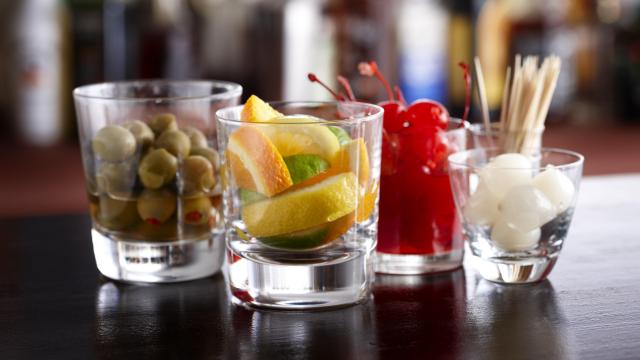When I was very (very) young, I ate an entire box of crayons in the hope of having multi-coloured poop. It did not work, but it did cause my mother a few hours of mild distress as she worried what might happen to me. The answer (disappointingly) was nothing. I didn’t extrude a rainbow, nor did I die horribly from periwinkle poisoning. As a direct result, I can personally confirm that your body can — and will — process a great many things you really shouldn’t be putting into it.
At a certain point, most of us figure out that eating non-food things like crayons or glue is a poor use of our time, especially when you realise you live in a world where things like chicken wings and beer exist. That doesn’t mean everything that’s technically considered food should be eaten, though. In fact, there are several examples of edibles things you should never actually eat.
Garnishes
Cocktail garnishes serve a dual purpose: They can enhance the flavour and texture of a drink while also increasingly its visual appeal. Garnishes definitely pop in your Insta posts, and they can make an ordinary mixture of ingredients look like something really fancy. And yes, most (but not all) garnishes served with cocktails are one hundred per cent edible, because they are food — typically fruits, veggies, or occasionally sprigs of spices (or, in the case of Bloody Marys, bacon).
So you can eat them, but you should not eat them. Never. Those garnishes were likely peeled, sliced, and dumped into a glass hours earlier, instantly becoming a welcoming host for all kinds of microbes.
Bar nuts
Similar to a garnish, those bowls of free snacks your local watering hole slaps on the bar are technically food, and thus technically edible. Bars love providing snacks because they’re super cheap, the salt encourages you to drink more, and patrons perceive them as a freebie so they’re popular.
They are also among the least sanitary places on the Earth. Even if you watch your bartender scoop a “fresh” pile of nuts or chips into a bowl just for you, there’s a good chance they’ve been sitting around for a long, long time, and a non-zero chance they were reclaimed from previous bowls. And if the bowl is already sitting there when you arrive, you obviously have no idea what kind of gross, horrible human had their filthy mitts in that bowl before you. Bottom line: Order something from the kitchen.
Raw dough
Raw dough — especially cookie dough — is hard to resist. First of all, if you’re baking up something delicious because you’re hungry, it’s very tempting to just scoop up some of that dough and slurp it down. And like many of nature’s perfect assassins, there’s no obvious sensory warning that the stuff can kill you. But the stuff can kill you.
Most of the flour used in baking is, in fact, raw. That doesn’t seem to make sense right off the bat because we think of “raw” mostly in terms of meat, but the “raw” in flour means it hasn’t been treated in any way — making it a great place for stuff like E. Coli to grow. The only way to ensure those contaminants get killed off before you eat them is to cook or bake them. Additionally, the eggs used in that dough can contain salmonella.
If raw dough is so dangerous, though, why can you buy a pint of cookie dough ice cream? Because that dough has been made using pasteurised eggs and heat-treated flour.
Raw meat
When I was a kid, my father regularly terrorised his family by wandering into the kitchen while dinner was being prepared, scooping up a handful of raw ground beef, and eating it with relish. He claimed it was an old tradition in his family. He also died pretty young, and I’m not entirely certain the two things are unrelated.
While it’s true that you can order and enjoy a variety of raw meat dishes in restaurants, including the famous steak tartare (which includes a raw egg for extra health gambling) or beef carpaccio, it’s actually never a good idea to eat raw meat. It’s an ideal breeding ground for bacteria, including E. Coli and salmonella, and every time you eat some raw meat you’re taking a risk of getting really sick.
So why is eating raw fish in sushi OK? Because sushi-grade fish is processed using freezing temperatures to kill off bacteria and parasites before being prepared for you — a step most raw meat dishes do not go through.
Pet food
It seems like an urban legend, but the fact is some folks have eaten pet food in order to survive desperate economic times. And pet food has been getting increasingly fancy in recent years, resulting in the bizarro situation wherein your cat’s dinner looks better than yours.
But no matter how curious (or desperate) you are, you shouldn’t start sharing your pet’s bowl. While eating pet food won’t cause you any immediate problems (it’s food, after all), pet food is formulated to deliver a different slate of nutrients and vitamins than what the human body needs or tolerates well. Regularly eating pet food will eventually cause negative health outcomes (some of the vitamins in dog food, for example, are perfectly safe for your dog but toxic for you), and over the long haul, you might even suffer malnutrition. Many pet foods don’t bother including vitamin C, for example, so you could actually wind up getting scurvy if you dine with your dog all the time.

Leave a Reply
You must be logged in to post a comment.